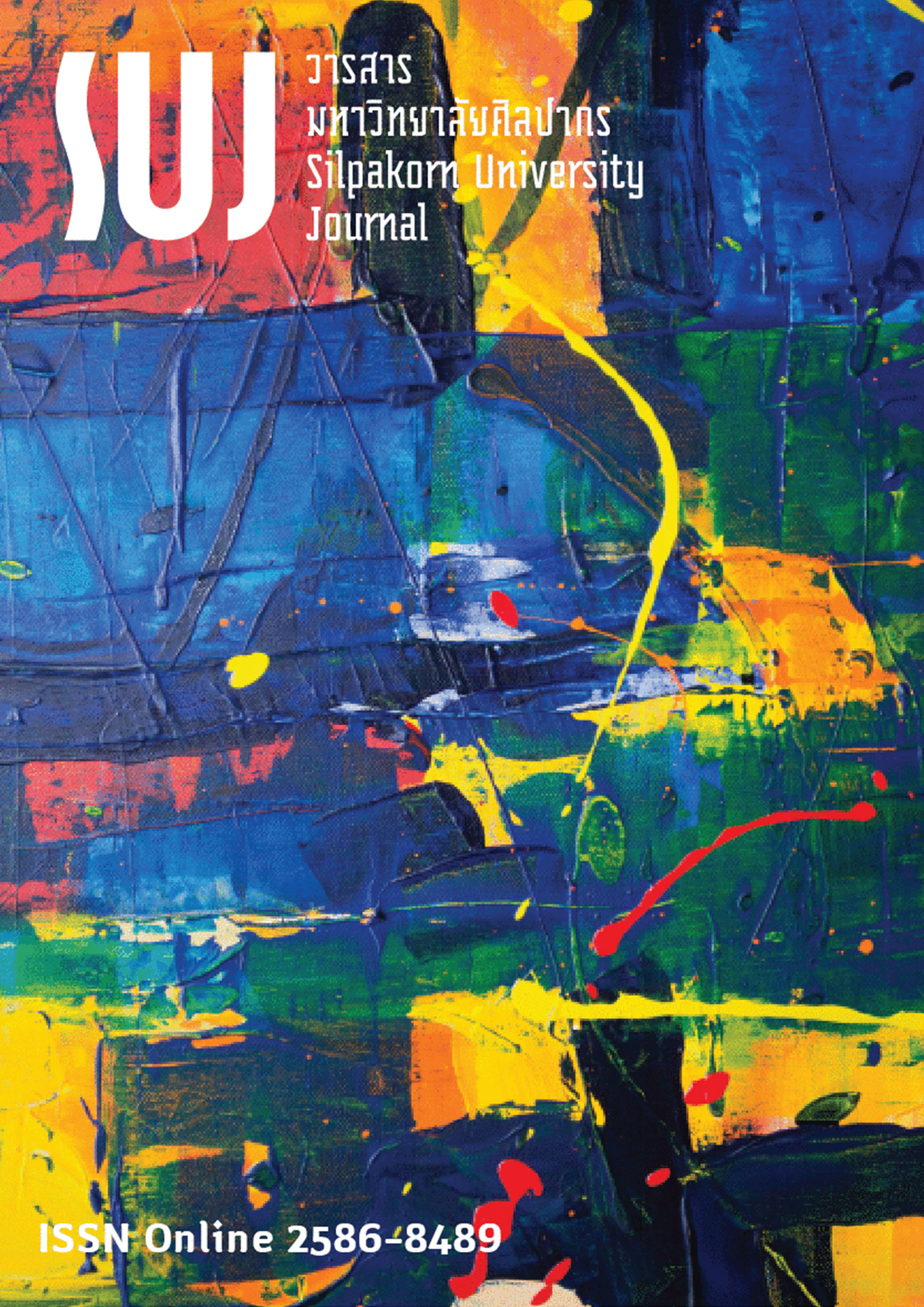กระบวนการมีส่วนร่วมภาคีการท่องเที่ยวในการท่องเที่ยวเชิงสุขภาพประเภทน้ำพุร้อนจังหวัดเชียงราย (The participation of tourism networks in hot spring wellness tourism in Chiang Rai)
Main Article Content
Abstract
บทความวิจัยนี้มีวัตถุประสงค์เพื่อศึกษารูปแบบเครือข่ายความร่วมมือของภาคีการท่องเที่ยวในการบริหารจัดการท่องเที่ยวเชิงสุขภาพประเภทน้ำพุร้อน และเพื่อศึกษากระบวนการในการมีส่วนร่วมของเครือข่ายภาคีการท่องเที่ยวของแหล่งท่องเที่ยวเชิงสุขภาพประเภทน้ำพุร้อนเพื่อการท่องเที่ยวอย่างยั่งยืน เป็นการวิจัยแบบเชิงคุณภาพ เก็บรวบรวมข้อมูลเชิงคุณภาพ ใช้แบบสัมภาษณ์เชิงลึก และการประชุมกลุ่มย่อย วิเคราะห์ข้อมูลเชิงพรรณนา ผู้ให้ข้อมูลเชิงลึก จำนวน 45 คน 3 พื้นที่ในแหล่งท่องเที่ยวน้ำพุร้อนในจังหวัดเชียงราย ประกอบด้วย 1) น้ำพุร้อนโป่งพระบาท ตำบลบ้านดู่ อำเภอเมือง 2) น้ำพุร้อน ป่าตึง ตำบลป่าตึง อำเภอแม่จัน และ 3) น้ำพุร้อนทุ่งเทวี ตำบลบ้านโป่ง อำเภอเวียงป่าเป้า จังหวัดเชียงราย ผลการศึกษา พบว่า ทั้ง 3 พื้นที่ยังไม่มีรูปแบบของภาคีเครือข่ายทางการท่องเที่ยวที่ชัดเจน เป็นรูปแบบของคณะกรรมการการพัฒนาน้ำพุร้อนที่องค์กรบริหารส่วนท้องถิ่นจัดตั้งขึ้น เพื่อพัฒนาแหล่งท่องเที่ยวน้ำพุร้อนในแต่ละพื้นที่ ผลการศึกษากระบวนการในการมีส่วนร่วมของเครือข่ายภาคีการท่องเที่ยวของแหล่งท่องเที่ยวเชิงสุขภาพประเภทน้ำพุร้อนเพื่อการท่องเที่ยวอย่างยั่งยืน พบว่ามี 4 ขั้นตอนคือ 1) การมีส่วนร่วมในการวางแผน 2) การปฏิบัติการหรือดำเนินงานโดยการจัดตั้งคณะกรรมการภาคีเครือข่ายการท่องเที่ยวเชิงสุขภาพน้ำพุร้อนเพื่อร่วมการจัดทำแผนพัฒนาทางการท่องเที่ยวเชิงสุขภาพแต่ละพื้นที่ 3) การจัดสรรผลประโยชน์ร่วมกัน ชุมชนต้องการจัดสรรพื้นที่ขายสินค้าของชุมชนในแหล่งท่องเที่ยว การรวมกลุ่มทางการท่องเที่ยวโดยนำเสนอการขายผลิตภัณฑ์ชุมชน จัดทำช่องทางการจัดจำหน่ายผลิตภัณฑ์ผ่านสื่อการตลาดออนไลน์ เพื่อให้สอดคล้องกับสถานการณ์โรคระบาดโควิด-19 และ 4) การติดตามประเมินผลกิจกรรมหรือโครงการของชุมชน ทั้งนี้ยังไม่มีการประเมินผลที่เป็นรูปธรรมและไม่มีกิจกรรมการประเมินผลที่ภาคีเครือข่ายการท่องเที่ยวเชิงสุภาพได้เข้ามามีส่วนร่วม ข้อเสนอแนะ คือ ควรพัฒนาเครือข่ายการท่องเที่ยวเชิงสุขภาพให้ทุกภาคส่วนเข้ามีส่วนร่วมอย่างจริงจัง
This article aims to study the model of tourism networks’ hot springs management for sustainable wellness tourism and their process of participation. It is qualitative research which collected data by using an in-depth interview and small group meeting. There was a descriptive analysis of 45 in-depth data providers from three areas of hot spring tourist attractions in Chiang Rai which were 1) Pong Phrabat Hot Spring, Ban Du Subdistrict, Mueang District, 2) Pa Tueng Hot Spring, Pa Tueng Subdistrict, Mae Chan District, and 3) Tung Taewee Hot Spring, Ban Pong Subdistrict, Wiang Pa Pao District. The results of the study showed that all three areas did not have clear forms of tourism network partners. They simply had a hot spring development committee commissioned by local administrative organization to develop hot spring tourist attractions in each area. The results of the study revealed that there were four participation processes of tourism networks of hot spring health tourism for its sustainability which were 1) participation in planning, 2) setting up a committee to formulate a wellness tourism development plans for each area, 3) allocating joint benefits for the community such as creating distribution channels for local product sales both in tourist sites and through online marketing materials during the COVID-19 situation, and 4) monitoring and evaluating activities of the community. To date, there has not been concrete assessment by the tourism networks. It is recommended that all private and public sectors should be included to seriously develop a wellness tourism network.
Downloads
Article Details

This work is licensed under a Creative Commons Attribution-NonCommercial-NoDerivatives 4.0 International License.
References
Chaipiarn, Thitialina. (2015). Public Participation in Mueng Nga Sub-District Municipality, Mueng Lamphun District, Lamphun Province: A Process of Local Development Plan (การมีส่วนร่วมของประชาชนในเขตเทศบาลตำบลเหมืองง่า อำเภอเมืองลำพูน จังหวัดลำพูน : ภายใต้กระบวนการจัดทำแผนพัฒนาท้องถิ่น). Master’s dissertation, Nation University, Lampang, Thailand.
Chuamuangphan, Nipon, Srisomyong, Niorn, Vajirakachorn, Thanathorn, Prayoonchart, Jainuch, & Samalapa, Chinnakarn. (2018). The Study of Types of Community Participation for Community-Based Tourism Development at Nong Ya Plong Hot Spring, Petchburi Province (การศึกษารูปแบบการมีส่วนร่วมของชุมชนเพื่อการพัฒนาการท่องเที่ยวโดยชุมชน แหล่งน้ำพุร้อนหนองหญ้าปล้อง จังหวัดเพชรบุรี). In Proceedings of The 2nd UTCC Academic Day, (pp. 1250-1264). Bangkok: University of the Thai Chamber of Commerce.
Cohen, J. M., & Uphoff, N. T. (1980). Participations place in rural development: Seeking clarity through specificity. World Developments, 8(3): 213-235.
Conant, D. R. (2011). Five Steps to Building Your Network. Harvard Business Review. [Online]. Retrieved March 25, 2022 from https://hbr.org/2011/04/five-steps-to-building-your-ne
Creighton, J. L. (2005). The Public Participation Handbook: Making Better Decisions Through Citizen Involvement. San Francisco: Jossey-Bass.
Department of Mineral Resourses. (2022). Hot Springs in Thailand (น้ำพุร้อนในประเทศไทย). [Online]. Retrieved March 25, 2022 from http://www.dmr.go.th/ewtadmin/ewt/dmr_web/n_more_news.php?filename=hotthai
Global Wellness Institute. (2020). Wellness Tourism Initiative 2020 Global Survey Results. [Online]. Retrieved March 25, 2022 from https://globalwellnessinstitute.org/wp-content/uploads/2020/05/GWI_FACT_SHEET_LEISURE-TRAVEL_2020.pdf
Hollingshead, A., & Poole, M. S. (Eds.). (2012). Research Methods for Studying Groups and Teams: A Guide to Approaches, Tools, and Technologies. London: Routledge.
Kaewthep, Kanchana. (1995). Development of Human-Centered Community Culture (การพัฒนาแนววัฒนธรรมชุมชนโดยถือมนุษย์เป็นศูนย์กลาง). Bangkok: Catholic Council of Thailand for Development.
Pantarak, Sirinan, & Cheablam, Onanong. (2020). Development of community enterprises and networks for health tourism in Khanom district, Nakhon Si Thammarat province (การพัฒนากลุ่มวิสาหกิจชุมชนและเครือข่ายเพื่อการท่องเที่ยวเชิงสุขภาพ อำเภอขนอม จังหวัดนครศรีธรรมราช). Area Based Development Research Journal, 13(1): 1-15.
Prachachat Business. (2022). 2022, The Year that Transforms Thai Tourism, Moving towards “Quality-Sustainable Tourism” (2565 ปีพลิกโฉมเที่ยวไทย ก้าวสู่ “ท่องเที่ยวคุณภาพ-ยั่งยืน”). [Online]. Retrieved March 25, 2022 from https://www.prachachat.net/tourism/news-834718
Rasoolimanesh, S. M., & Jaafar, M. (2016). Community Participation toward Tourism Development and Conservation Program in Rural World Heritage Sites. In L. Butowski (Eds.), Tourism - From Empirical Research towards Practical Application, (pp. 1-14). London: InTechOpen.
Srivichian, Orrapin. (2009). The Citizen’s Perception in Participation in the Making of Bangkok Comprehensive Plan (การรับรู้เรื่องการมีส่วนร่วมของประชาชนในการวางและจัดทําผังเมืองรวมกรุงเทพมหานคร). Master’s dissertation, Thammasat University, Pathumthani, Thailand.
Suwanvong, Danuvat, & Kreoksakul, Patarapong. (2016). The Network Development Community Base Tourism at 5 Southern Border Provinces (Satun, Songkhla, Pattani, Yala, and Narathiwat) with Connected Tourism in 4 States (Kelantan, Perak, Kedah and Perlis) of Malaysia (การพัฒนาเครือข่ายการท่องเที่ยวโดยชุมชนในเขตพื้นที่ 5 จังหวัดชายแดนภาคใต้ (สตูล สงขลา ปัตตานี ยะลา และนราธิวาส) กับการเชื่อมต่อพื้นที่การท่องเที่ยวใน 4 รัฐ (กลันตัน เปรัค เคดาห์ และเปอร์ลิส) ประเทศมาเลเซีย). Songkhla: Songkhla Rajabhat University.
Timprasert, Narudom. (2011). People’s Participation Process Based on Community Rights to Preparation the Local Ordinances Sea: A Case Study of Tha Sala Sub District Administration Organization, Nakhon Si Thammarat (กระบวนการมีส่วนร่วมของประชาชนที่ตั้งอยู่บนพื้นฐานของสิทธิชุมชนในการจัดทำข้อบัญญัติท้องถิ่นทางทะเล: กรณีศึกษาองค์การบริหารส่วนตำบลท่าศาลา จังหวัดนครศรีธรรมราช). Master’s dissertation, National Institute of Development Administration, Bangkok, Thailand.
Tosun, C. (1999). Towards a typology of community participation in the tourism development process. Anatolia, 10(2): 113-134.


